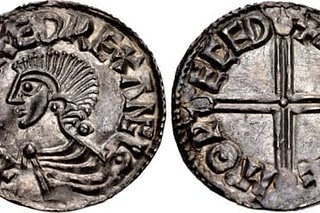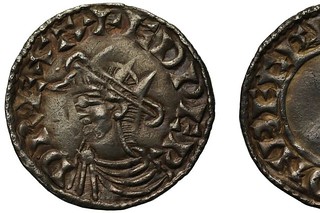
PREV ARTICLE
NEXT ARTICLE
FULL ISSUE
PREV FULL ISSUE
WATCHET MUSEUM DISPLAYS ANGLO-SAXON COINSA museum in Watchet, Somerset, England is displaying Anglo-Saxon coins related to the coastal town's history. -Editor Two rare Saxon coins minted in Watchet will go on display at the Watchet Market House Museum from March. They are being loaned to the museum by Carhampton resident Cliff Barber.
The coin is a silver penny, which was the standard for Saxon coins. Curator and Chairman of the Watchet Market House Museum Jimmy Nicholson said: "It is of interest because the mint was set up during King Alfred the Great's time up on Cleve Hill. The Vikings knew there was silver in Watchet, that's one of the reasons why they raided. Watchet's silver was even used to pay off the Danes." The so-called monyer, the man who minted the coin, is recorded as being named Sigeric. In Saxon times the monyer was an important position, held by a responsible man of property in order to give credibility to the money he made.
This coin is also a silver penny, weighing in at 1.1g. It is said to be of the highest rarity, being one of only 4 known examples of its kind. Jimmy Nicholson said: "It is of the short cross type - in the middle of the coin there is a short cross - whereas others have a long cross. They used to cut them in half along the cross to make a half penny." The monyer of the coin is recorded as being named Godcild. Cliff Barber's Saxon coins will join two other Roman coins he has on display at the museum, which depict Romulus and Remus. Romulus and Remus are said to have been the founders of the city of Rome, and according to legend were raised in the wild by a wolf. Steve Hill of Sovereign Rarities Ltd put me in touch with Mr Clifford Barber, one of his clients who'd bought the rare Watchet Mint penny of Edward the Confessor from the English Doctor collection last year, and arranged for it and another coin of Aethelred II he had, to go on display at the Watchet Museum. Cliff added these thoughts. Thank you! -Editor I thought a little back ground about Watchet may be of help. Watchet is a typical very independent minded community on the west coast of England. There is evidence of continual community dating back to before the Celtic era. Daws castle (as it is known now) started as a Celtic hill fort and there is evidence of Roman presence but not settlement. The Saxons used the hill fort and it is believed that the Saxon mint was within the defences of the hill fort. Watchet was attacked by Viking raiders on several occasions with varying degrees of success. Moving to the 1700s the Bell pub across the road from the Watchet museum is where Samuel Taylor Coleridge started to composed The Rime of the Ancient Mariner. The first part is leaving Watchet harbour with the church on top of the hill and the light house on the harbour wall. The ship was cheered, the harbour cleared, Merrily did we drop Below the kirk, below the hill, Below the lighthouse top.
To read the complete article, see:
Wayne Homren, Editor The Numismatic Bibliomania Society is a non-profit organization promoting numismatic literature. See our web site at coinbooks.org. To submit items for publication in The E-Sylum, write to the Editor at this address: whomren@gmail.com To subscribe go to: https://my.binhost.com/lists/listinfo/esylum All Rights Reserved. NBS Home Page Contact the NBS webmaster 
|



